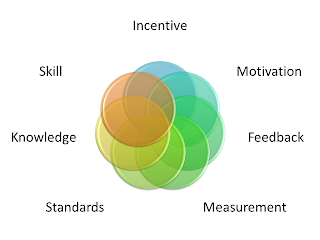Success Factors for Training
 What are those things in your training business (university, division, unit) that you believe will help you achieve a successful outcome to your business strategy? They may be related to cost reduction, corporate objectives, new technology, process changes, etc. What will help ensure your success? They may be unique to your training business or new products for your customers. The standard things for a successful training business are adequate capital, cash flow, good employees, and customers. These are not the success factors for your business - they are the result of your success factors. Again, you need to establish the key success factors that will complement your business strategy. What gets the customer to choose your product and - call you; browse your web site; meet and buy from your sales person; or come into your training center?
What are those things in your training business (university, division, unit) that you believe will help you achieve a successful outcome to your business strategy? They may be related to cost reduction, corporate objectives, new technology, process changes, etc. What will help ensure your success? They may be unique to your training business or new products for your customers. The standard things for a successful training business are adequate capital, cash flow, good employees, and customers. These are not the success factors for your business - they are the result of your success factors. Again, you need to establish the key success factors that will complement your business strategy. What gets the customer to choose your product and - call you; browse your web site; meet and buy from your sales person; or come into your training center?
 |
| Call Me! |
Success Factors fall into several categories:
- Set realistic business objectives and goals
- Understand your unique value proposition
- Evaluate your competition
- Articulate your value proposition
- Focused marketing and sales teams, everyone is in sales
- Invest in the future
- Knowledgeable work force
The ABC's, DEF's and G's of Success Factors:
Success Factor A: Your vision, mission, objectives, and goals must stretch the organization utilizing reasonable milestones and performance indicators that fall within your available investment and budget plans.
Success Factor B: Clearly establish your value proposition that identifies your target customers and why your product/service is better than anyone else in the market. In training groups you often have both internal and external customers.
Success Factor C: Do a SWOT analysis on your competition. Then do yours and compare yourself against the results. Once done you will have differentiation points for your marketing programs. Remember training groups are often competing with other internal organizations for training delivery and programs. Make sure you know who, what, and how they operate.
Success Factor D: Invest in marketing! Your marketing strategy is very important to articulate your value proposition. Once you have your marketing strategy and approach defined along with the product message and, points of differentiation you are ready for an "everyone involved" program to integrate this market strategy into your product development, course development, and sales organizations. If you are a one person group then you are all of the above. Target how you will market your solutions to your internal or external customers. It can often be harder to sell internally then externally.
Success Factor E: Everyone in your training organization is in 'sales'. This includes instructors, writers, etc. Everyone must understand this, it has been said over and over - Nothing Happens Without Customers. A very critical factor is to create a symbiotic relationship between your organization and internal users of your services - one cannot exist without the other. Goals, milestones and objectives must match.
Success Factor F: Prudently invest in the future. Invest in productivity tools, people, ideas. Strategic investments should be made in people, marketing, and sales to build a solid training infrastructure. Be bold. Look for learning everywhere in the organization. Closely manage your cash-flow. Be open to creative hiring practices that have a win-win outcome for your training group and the individuals.
Success Factor G: Keep in mind your competitors (internal or external) are looking for weaknesses. Never underestimate the speed at which a competitor can overtake you. Execution of your strategy is everything. You must stay focused and lead your organization to success through enlightened execution. Everyone in the organization must be on-board, trained and knowledgeable about the business plans and objectives. Only through wide-spread adoption of the vision by the entire training organization can the university, division, or unit ensure success in the marketplace. Invest in training and education for your group to keep them at the "expert" level.
Success Factor Examples:
- Restructure to create customer focus
- Establish strategic training centers
- Create programs to meet specific division objects
- Implement new delivery methods (be creative)
- Develop market theme for course 'x'
- Invest in new supply chain for 'canned' training
- Ensure company Sales force has access to latest customer training courses
- Establish a new training center in Brazil to meet expanding corporate programs
- Define new hire strategy for courseware developers



I believe this is among the such a lot significant information for me and I am happy reading your article. Corporate Training
ReplyDelete